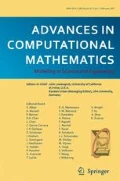Abstract
Given f and ∇f at the vertices of a rectangular mesh, we build an interpolating function f by a subdivision algorithm. The construction on each elementary rectangle is independent of any disjoint rectangle. From the Hermite data associated with the vertices of a rectangle R, the function f is defined on a dense subset of R. Sufficient conditions are found in order to extend f to a C 1 function. Moreover, infinite products and generalized radii of matrices are used to study the convergence to a C 1 function. This convergence depends on the five parameters introduced in the algorithm.
We’re sorry, something doesn't seem to be working properly.
Please try refreshing the page. If that doesn't work, please contact support so we can address the problem.
References
M.A. Berger and Y. Wang, Bounded semigroups of matrices, Linear Algebra Appl. 166 (1992) 21-27.
I. Daubechies and J.C. Lagarias, Set of matrices all infinite products of which converge, Linear Algebra Appl. 161 (1992) 227-263.
G. Deslauriers and S. Dubuc, Interpolation dyadique, in: Fractals. Dimensions Non Entières et Applications (Masson, Paris, 1987) pp. 44-55.
G. Deslauriers, J. Dubois and S. Dubuc, Multidimensional iterative interpolation, Canad. J. Math. 43 (1991) 127-147.
S. Dubuc, Interpolation through an iterative scheme, J. Math. Anal. Appl. 114 (1986) 185-204.
N. Dyn, D. Levin and J.A. Gregory, A 4-point interpolatory subdivision scheme for curve design, Comput. Aided Geom. Design 4 (1987) 257-268.
N. Dyn and D. Levin, Analysis of Hermite-type subdivision schemes, in: Approximation Theory VIII, Vol. 2: Wavelets and Multilevel Approximation, eds. C.K. Chui and L.L. Schumaker (World Scientific, Singapore, 1995) pp. 117-124.
L. Elsner, The generalized spectral-radius theorem: An analytic-geometric proof, Linear Algebra Appl. 220 (1995) 151-159.
G. Gripenberg, Computing the joint spectral radius, Linear Algebra Appl. 234 (1996) 43-60.
J.-L. Merrien, A family of Hermite interpolants by bisection algorithms, Numer. Algorithms 2 (1992) 187-200.
J.-L. Merrien, Interpolants d'Hermite C 2 obtenus par subdivision, to appear in M2AN.
R. Sibson and G.D. Thomson, A seamed quadratic element for contouring, Comput. J. 24 (1980) 378-382.
Author information
Authors and Affiliations
Rights and permissions
About this article
Cite this article
Dubuc, S., Merrien, JL. Dyadic Hermite interpolation on a rectangular mesh. Advances in Computational Mathematics 10, 343–365 (1999). https://doi.org/10.1023/A:1018943002601
Issue Date:
DOI: https://doi.org/10.1023/A:1018943002601

